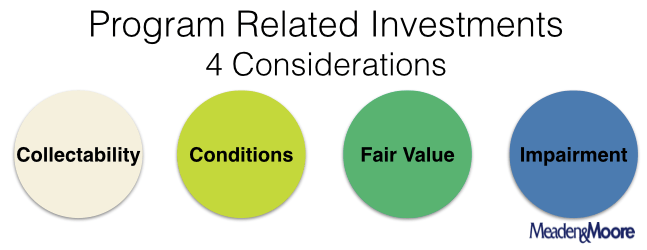Program Related Investments: Gaining Momentum
Once considered underutilized (Forbes, “Why Program-Related Investments are Not Risky Business”, February 21, 2013), Program Related Investments (PRIs) are more often being considered as an option for foundations to financially support the mission of their favorite not-for-profit organizations. Instead of or in addition to a direct contribution or a grant, a not-for-profit may make a low interest, long term loan which is referred to as a PRI. This type of transaction offers both financial as well as programmic returns. There are both initial and established considerations for the accounting of these transactions.
Initial considerations for accounting and reporting:
- Determine the character of the contribution as a PRI at the time of the transaction. Is the contribution part investment and part donation? There may be a split in how the transaction is recorded. One test to help in this determination is whether the loan has a market interest rate. If it does not, then the loan may be considered to have a contribution element.
- The main goal of the investment is not to generate market returns or appreciate, but to help advance the mission of the not-for-profit. The pay back of the loan provides the opportunity for the not-for-profit to make future gifts.
- The investment is considered a financial instrument and should be accounted for accordingly.
- Determination of the relative significant of the PRI for disclosures and presentation in the financial statements specific to the user.
Once established as a PRI, additional considerations:
- Collectability: consideration of collecting on a PRI may result in recording as contribution expense the portion considered uncollectible either at the time of the transaction or when determined as uncollectible. It would not be appropriate to record a loss allowance at the time the loan originates.
- Conditions: if there is a possibility that certain conditions when met, would result in loan forgiveness, the principal amount would be recognized as a contribution when the conditions have been met.
- Fair Value: by definition, PRIs are not classified as a security and are not subject to the fair value reporting requirements, unless an election is made to report at fair value.
- Impairment: based on current information and events, when a loan is impaired, the measurement is based on the present value of expected future cash flows discounted at the loan’s effective interest rate adjusted against a valuation allowance.
Disclosure requirements:
- If the not-for-profit uses PRIs as a major program activity the following should be disclosed:
- Number of loans outstanding
- Average face amount and average carry amount with explanation of differences
- The program purpose being accomplished by this activity
- Total impairment losses
While this article summarizes the accounting compliance, an organization should also consider the legal as well as the tax rules before moving forward considering if making a PRI is the best option.
Read Lynn's other posts on Not-for-Profit Organizations:
3 Internal Control Basics for Your Small Not-for-Profit Organization
When Should a Not-for-Profit Organization Make a Profit?
4 Considerations for Non Profit Transparency
Lynn Koster is a Senior Manager at Meaden & Moore in the Assurance Services Group and serves both closely held businesses and not-for-profit clients.









